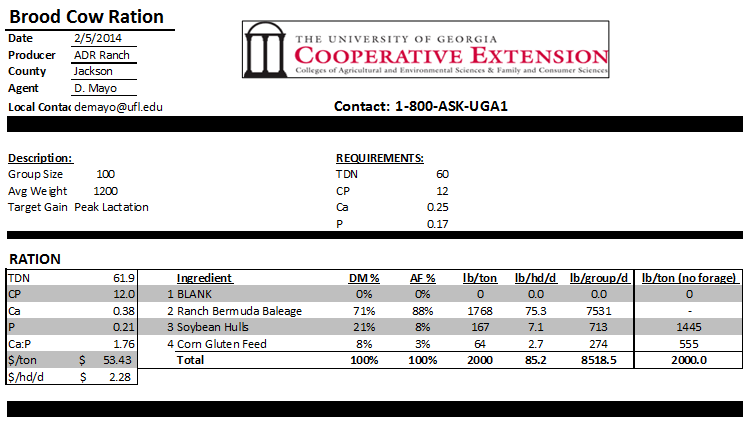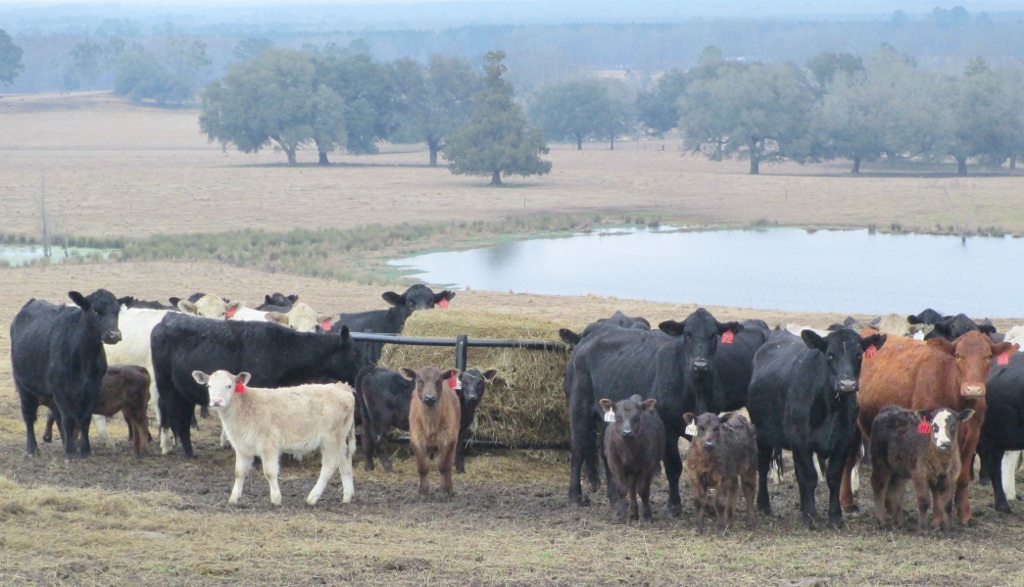 2013 was certainly a rough year for hay production in the Southeast; first it was too dry to produce enough hay to cut, then too wet to make a quality cutting of hay. As a result, most ranchers harvested over mature, low quality hay at the end of the growing season. Poor quality hay causes three problems once you start feeding it: 1- reduced consumption, 2 – reduced digestibility, and ultimately 3- reduced animal performance.
2013 was certainly a rough year for hay production in the Southeast; first it was too dry to produce enough hay to cut, then too wet to make a quality cutting of hay. As a result, most ranchers harvested over mature, low quality hay at the end of the growing season. Poor quality hay causes three problems once you start feeding it: 1- reduced consumption, 2 – reduced digestibility, and ultimately 3- reduced animal performance.
You may have noticed a problem in your herd this year, which is especially noticeable in older and younger cows. This problem is what some long-time cattlemen call “ADR Disease” or cattle that are not really sick, but they just “Aren’t Doing Right.” This problem may well be the result of an energy shortage, because your base forage is too low in quality to provide the energy to keep all of the body’s systems functioning. Energy is the fuel that cattle use to maintain their systems, produce growth, milk, and reproduce. When the ration you supply falls short of the daily requirements, cattle begin breaking down the fat stored over the summer to keep all of the systems operating. There does come a point when the cow’s fat is used up, she can’t get enough energy from the ration, causing the less essential systems start to shut down. Add in two rounds of extremely cold, arctic air and sleet, which drastically increased energy requirements, and the effects of an energy shortage become even more severe.
There are three steps to take to address an energy shortage:
1. Have you hay tested for forage quality
The following are forage test results from actual samples taken from Tifton 85 hay and round bale silage, aka baleage, cut at the same ranch in 2013. The information provided in the table below are on a dry-mater basis so we can have equal comparisons. Even though one is a dry hay and the other wet baleage, we can compare their nutrient quality or feeding value equally, once the moisture differences are factored out.
 You may have heard Beef Nutrition Specialists and Feed Salesmen talk about these numbers, but just like using EPD’s for cattle selection, it does take some practice and comparison of multiple samples to figure out what is good and what is not so good. Hay should at least have a Relative Forage Quality (RFQ) score of 90, 7% Crude Protein (CP), and 50% Total Digestible Nutrients (TDN) to meet the needs of dry, pregnant cows, so these numbers serve as a baseline for test comparisons.
You may have heard Beef Nutrition Specialists and Feed Salesmen talk about these numbers, but just like using EPD’s for cattle selection, it does take some practice and comparison of multiple samples to figure out what is good and what is not so good. Hay should at least have a Relative Forage Quality (RFQ) score of 90, 7% Crude Protein (CP), and 50% Total Digestible Nutrients (TDN) to meet the needs of dry, pregnant cows, so these numbers serve as a baseline for test comparisons.
Obviously there was a difference in these two samples. With round bale silage, or baleage, you can cut, wilt, wrap, and preserve hay the same day you mow it down. In wet years like 2013, this is a huge advantage. Both of these samples came from the same ranch, but the dry hay was much more mature, because the rancher had to wait for multiple drying days before cutting.
2. Know nutrient requirements of the animals to be fed
Once you know the forage quality or feed value of your base forage, the next step is knowing the nutrient requirements of the animals you are feeding. The main nutrient requirements used to formulate cattle diets are dry matter intake, crude protein, and total digestible nutrients.
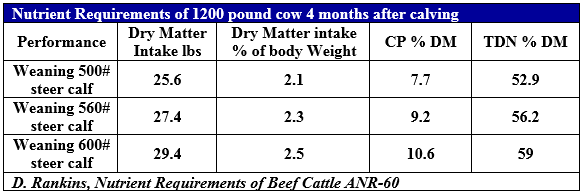 Forage intake is influenced by nutrient quality of the feed, and animal requirements, based on their stage and level of production. The more nutrient rich the feed the more cows will eat, and the greater the need, the more they will eat. Mature cows will eat 1.5- 2.7 % of their body weight each day, depending on what they are fed. The Dry Matter Intake (DMI) estimate for the samples provided were 1.8% for the dry hay and 2.3% for the baleage. Just from this estimate we can see that cattle will voluntarily eat more of the baleage than the dry hay each day. A first-calf heifer, or a heavy milking cow will generally eat more than a mature pregnant cow.
Forage intake is influenced by nutrient quality of the feed, and animal requirements, based on their stage and level of production. The more nutrient rich the feed the more cows will eat, and the greater the need, the more they will eat. Mature cows will eat 1.5- 2.7 % of their body weight each day, depending on what they are fed. The Dry Matter Intake (DMI) estimate for the samples provided were 1.8% for the dry hay and 2.3% for the baleage. Just from this estimate we can see that cattle will voluntarily eat more of the baleage than the dry hay each day. A first-calf heifer, or a heavy milking cow will generally eat more than a mature pregnant cow.
In the example above from the Alabama Extension publication, higher producing cows require more feed each day, but you can also see that it takes a more nutrient rich feed with a higher percentage of protein and energy to produce heavier calves at weaning. Once you have compared the forage test results to the specific requirements of the cow, it becomes obvious that you must either add some sort of supplement to the daily ration to maintain her performance, or wean the calf to reduce the cow’s requirements. Otherwise performance, reproduction, and even the immune system will suffer from a shortage of energy.
3. Select supplements to balance your forages
There are a wide variety of feed options for winter supplementation. Bulk feeds are the least expensive, but require more investment of storage space and equipment to feed it. Liquid feeds and self-limiting feed blocks offer the most convenience, but generally cost the most to feed. There are also a wide variety of commercial bagged feeds that fall somewhere in the middle of the price range.
There are a number of Extension publications that offer some guidance on supplement selection. (See links at the end of the article) There are also some decision aids available that can help cattle ranchers decide which supplements to use and how much to feed, such as the UGA Basic Balancer. To use this you will need some idea of the current costs of different feeds for comparison. The USDA provides a weekly feedstuff market report that can be helpful for comparing commonly used bulk feeds. From the feedstuff market report below we can see that the FOB price of soybean hulls was $210/ton, and corn gluten feed was $235 per ton last week.
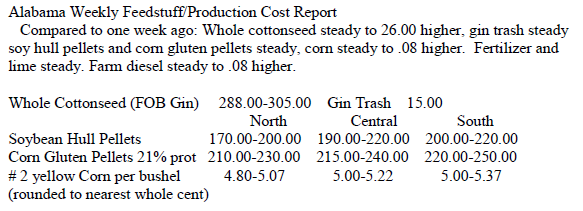 The following is an example of the type of information the UGA Basic Balancer program can provide. This Excel spreadsheet is free and comes preloaded with cattle requirements and some typical feedstuffs. You can also add in your hay and other feed supplements. To keep this example simple, corn gluten feed and soybean hulls were the only supplements used to compare the two forage samples.
The following is an example of the type of information the UGA Basic Balancer program can provide. This Excel spreadsheet is free and comes preloaded with cattle requirements and some typical feedstuffs. You can also add in your hay and other feed supplements. To keep this example simple, corn gluten feed and soybean hulls were the only supplements used to compare the two forage samples.
Tifton 85 Hay Ration
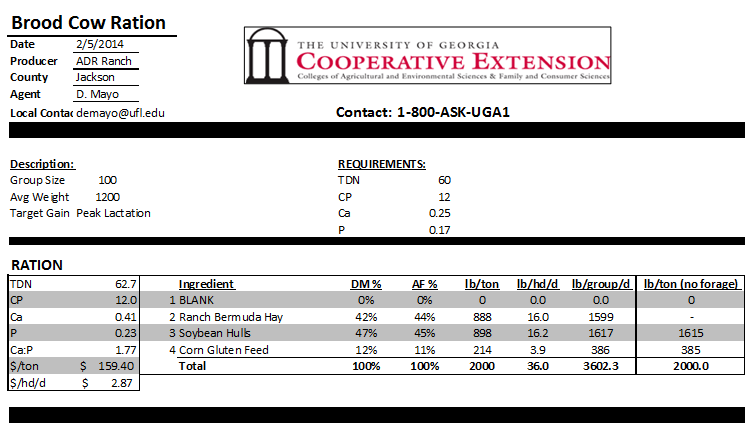
The Ranch Hay requires 20 pounds of supplemental feed to meet a 1200 pound cows requirements at peak lactation.
Tifton 85 Baleage Ration
The UGA Basic Balancer comes preloaded with estimated cow requirements based on the stage of production. It also comes with some common feedstuffs preloaded and some empty lines to add in forages and feeds of the user’s choice. Using this program we can estimate that if you are feeding 1200 pound cows at peak lactation, it would take 16 pounds of soybean hulls and 4 pounds of corn gluten feed per day to meet the cow’s nutrient requirements using the low quality hay as a base forage. Conversely, if you were using the higher quality baleage as the base forage, only 7 pounds of soybean hulls and 3 pounds of corn gluten feed would be required to meet her daily nutrient requirements. This difference in supplemental feed would add an extra $0.39/head/day to supplement the lower quality hay as compared to the baleage.
Forage testing, nutrient requirements, supplemental feed prices, ration balancing, and ration comparisons are all areas that your County Agent and their supporting Beef Cattle Extension Specialists can assist ranchers with. The examples provided in this article of balancing both the hay and baleage show the need for increased protein and energy supplementation, especially for cows in peak lactation. If your cows are losing weight and looking poorer than normal, you may want to seek some help to evaluate your winter feeding program and see if you are dealing with an energy shortage.
Helpful Resources:
Step 1 – Forage Test Forms:
Step 2- Nutrient Requirements:
-
Basic Nutrient Requirements of Beef Cows
-
Nutrient Requirements of Beef Cattle ANR-60
-
Beef Cattle Nutrient Requirement Tables
Step 3 – Supplement Selection & Ration Balancing
-
Strategies for Cost-Effective Supplementation of Beef Cattle
-
By-Product Feeds for Alabama Beef Cattle
-
Using By-Product Feeds
-
Beef Magazine Feed Composition Guide
-
UGA Basic Balancer: Instructions and Excel Decision Aid
- Northwest Florida Beef Cattle Conference & Trade Show – February 11 - December 19, 2025
- Friday Feature:The Sears Catalog –How Rural America Shopped before the Internet - December 19, 2025
- November 2025 Weather Summary & Winter Outlook - December 5, 2025

